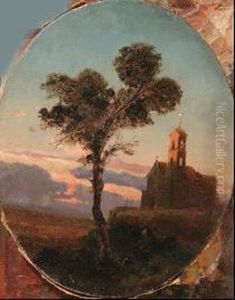Raffaele Belliazzi Paintings
Raffaele Belliazzi was an Italian sculptor, born in 1838 in Naples, a city with a rich artistic heritage that significantly influenced his development as an artist. He emerged during a period when Italy was undergoing significant transformation, both politically and culturally, with the unification of Italy (Risorgimento) happening around the same period. This era was marked by a resurgence of interest in the arts, with patronage expanding beyond the church to include the newly unified state and affluent individuals who were keen to commission works that reflected the nation's burgeoning sense of identity and pride.
Belliazzi trained at the Accademia di Belle Arti di Napoli, one of Italy's foremost art academies, where he honed his skills in sculpture. His work is characterized by a blend of classical traditions with the burgeoning spirit of Romanticism, reflecting the tumultuous era he lived in. He was adept in marble and bronze, and his sculptures often depicted historical figures, allegorical subjects, and themes from mythology, imbued with a sense of realism and emotional depth.
Throughout his career, Belliazzi was involved in various significant projects and commissions that contributed to his reputation as a leading sculptor of his time. Among his notable works are monuments and public statues that still stand in Naples and other parts of Italy, serving as a testament to his artistic legacy. Despite the prominence he achieved during his lifetime, Belliazzi's work, like that of many of his contemporaries, was later overshadowed by the avant-garde movements of the early 20th century, which sought to break away from the classical and romantic traditions that he epitomized.
Raffaele Belliazzi passed away in 1904, leaving behind a body of work that, while perhaps not as widely recognized today, played an important role in the cultural and artistic landscape of 19th-century Italy. His contributions to Italian sculpture are a reflection of a period of nationalistic fervor and artistic revival, and his works remain an integral part of Italy's rich cultural heritage.

